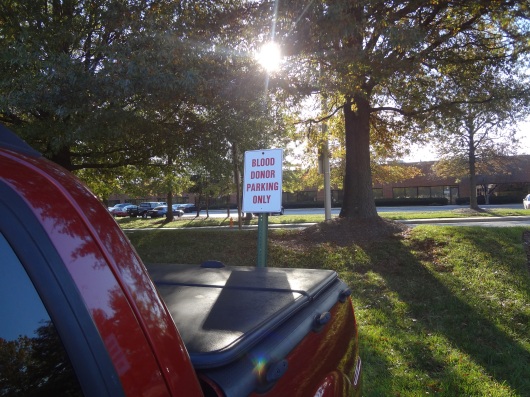Note: This is only my experience while donating blood. Your experience, like your diabetes, may vary.
I got up early the Saturday before last, had breakfast, and made my way to the American Red Cross Mt. Hope Donor Center in Baltimore. I had intended to write about the blood donation process; being transparent about what transpires is a good thing.
But… sometimes, your blood sugar numbers just get in the way of your best-laid plans.
I arrived at the center about ten minutes early Saturday. I figure, early in, early out. Prior to going in, I checked my BG and it was 156 mg/dL (8.6 mmol/L). I did carry my meter in with me, which you should do too if you decide to donate blood.
I was not concerned about this number, but I knew my BG would probably come down during the donation process, so as I entered the center I suspended my pump. What if I wound up high later? I didn’t care. In this case, better to be high than to go too low during the donation process.
I went through the initial reading of information, being tested for anemia, and answering questions to make sure I didn’t have any conditions and that I’m not taking any medications that would preclude me from giving blood. Then it was on to the donation.
I went through the donation process (see photos), and during this entire time I thought I was okay, but in fact, I was dropping. When the donation process was complete, we’re encouraged to take a moment and have a snack and a little juice, so our blood sugar can recover from the process. I was sure that since my pump had been suspended for about an hour after my BG was 156, I wouldn’t have a problem with that.
I sat down, and the first thing I did was pull my meter out of my pocket and check. Which, if you decide to donate blood, you should do too. What was the result? 50 mg/dL (2.8 mmol/L).
Wow. I had a little juice and a bag of pretzels. Twenty minutes go by, and I’m sure I must be higher. Don’t forget, I haven’t restarted my pump yet. My next check revealed: 59 mg/dL (3.2 mmol/L).
What? I was sure I was going to be okay after this, so I made the huge mistake of driving home. In retrospect, I feel horrible about driving at that point, but I should be honest, and that’s what I did. I drove home. It was about a ten minute drive, and I checked again once I got there: 56 mg/dL (3.1 mmol/L).
I’m now at the “I can’t believe this” stage. I downed a glass of juice and had a slice of bread with peanut butter. I waited another twenty-five minutes to check this time. Finally… at 11:20… 169 mg/dL (9.4 mmol/L). After nearly two hours, I finally started up my pump again.
I guess I always knew that my blood sugar could be affected by donating blood. But this experience was something I did not count on. So next time (and there will be a next time), I’ll be more prepared than ever.
There is currently a desparate need for whole blood and blood platelets for patients of all kinds. If you’re living with diabetes in the USA, you may still be able to donate blood– and save a life. Find all the info at redcrossblood.org, or send me an e-mail using the link in the upper-left corner of this page and I’ll tell you what I know.






Comments
Well, Stephen, everything you did was what you believed to be right at the time, so I wouldn’t dwell on the driving-home-while-low issue. What you did on that day was both honorable and admirable.
As for the BG dropping, I can’t tell from too much from personal experience since I’ve never given blood before (the closest I’ve come was being student chairperson at my high school blood drive), but I know BG goes down for EVERYONE when they donate blood. That’s why they have all of the sugary snacks available afterwards.
Doing some crude math from some poor memory, the average person donates a pint of blood… and has 5 pints (is that right? fact-check needed) of blood in their body. They give up 20%. Therefore, the concentration of glucose (mg/dl) stays the same, but the absolute amount of glucose (in mg) decreases by 20%. As your body regenerates the blood it lost, it comes mostly from water — no glucose. The glucose comes from the rest of the blood you (still) have,, which has a net effect of lowering BG by 20% — but this happens over time as your veins refill with blood and not immediately. This, I suspect, is why your initial treating of the low didn’t work: because as you were replenishing the “bucket” of blood, the bucket, at the same time, was getting bigger.
Just my convoluted logic. I’m probably wrong.
LikeLike
Makes perfect sense to me. I’m going with it. Thanks!
LikeLike
Wow, talk about a low that just wouldn’t quit!! But I so admire you for giving blood so often. I wish I had a way to be sure I never took beef insulin in the 80s – I should ask my mom if she recalls.
LikeLike
Trackbacks
[…] lightheaded when you’re hungry or are diabetic (currently, diabetics who control their blood sugar numbers well are eligible to donate blood in the United States), just make to eat a proper meal before […]
LikeLike